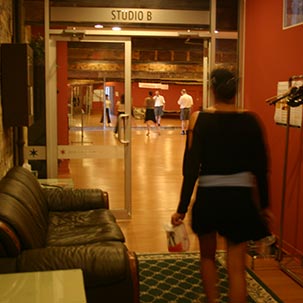The Shy Dancer’s Guide, Part One

Sweaty palms. Racing mind. Shaky legs. And that’s just from thinking about walking over to ask that beautiful girl for a dance. Before you’re halfway across the floor, your mind convinces you to reverse course, turn tail, slink back to the shadows, where you stew in frustration until the night is over. Even if it’s not as bad as that, fear of rejection plagues virtually all new dancers. There is no miracle solution – but there is a way to overcome it.
For those of you on the shier end of the spectrum, your mind can be your own worst enemy. Dancing with that cute girl (or boy) simply doesn’t feel like an option – you might as well scale Mount Everest in flip-flops. Therefore, the first thing that needs to change is how we are looking at the situation. Let’s start with a short lesson in psychology.
The most crippling thing fear can do to us is convince us something is doomed before we try it. Rationally, we know it’s possible, even likely that we will collect at least a few yeses if we can just blurt out ‘would you like to dance?’ to enough people. We tell ourselves everyone feels the same way, that onlookers are watching the better dancers, AKA, not us. But none of this touches the fear because it is not rational. It can’t be reasoned with. Fortunately, it can be trained to react differently.
Take any skill you’ve learned, and think back to when you were first learning it. Now compare how much thought you had to put into it then vs now. A lot more automatic now, isn’t it? Your subconscious learned, through repetition, to take care of your body in a situation that previously would have felt awkward, and maybe a little scary.
Just as we can train our body to do certain things, so we can train our mind to think things. Police officers, suicide hotline operators, psychologists and life coaches are just a few who’ve learned to handle high-pressure situations with calmness and control. And no, they weren’t ‘born to it’, as any of them will tell you. Even I, who started dancing out of sheer social awkwardness, gradually learned how to navigate a social dance floor with confidence. The practice is what made the difference.
‘So I need practice’, you say. ‘How the heck am I supposed to do that without freezing in terror?’ The same way all those professionals above learned to do it: By starting with something safer, practicing it until it felt good, then gradually upping the ante. For example, if you’re afraid of asking others to dance, you could start training your brain to respond better, simply by practicing the words in an empty room!
There’s countless ways you can gradually quiet your fears, which we will look at in part two. For now, just know that anything you do that pushes against your fear, even the slightest bit, is a step in the right direction.
About the Author
Ian Crewe has been dancing ballroom for over 18 years, and has a Licentiate in American smooth and rhythm. His passion for dance and his endless seeking for ways to reach new audiences eventually led him to blogging and the World Wide Web. Ian currently teaches at the Joy of Dance Centre, Toronto, ON, Canada.

